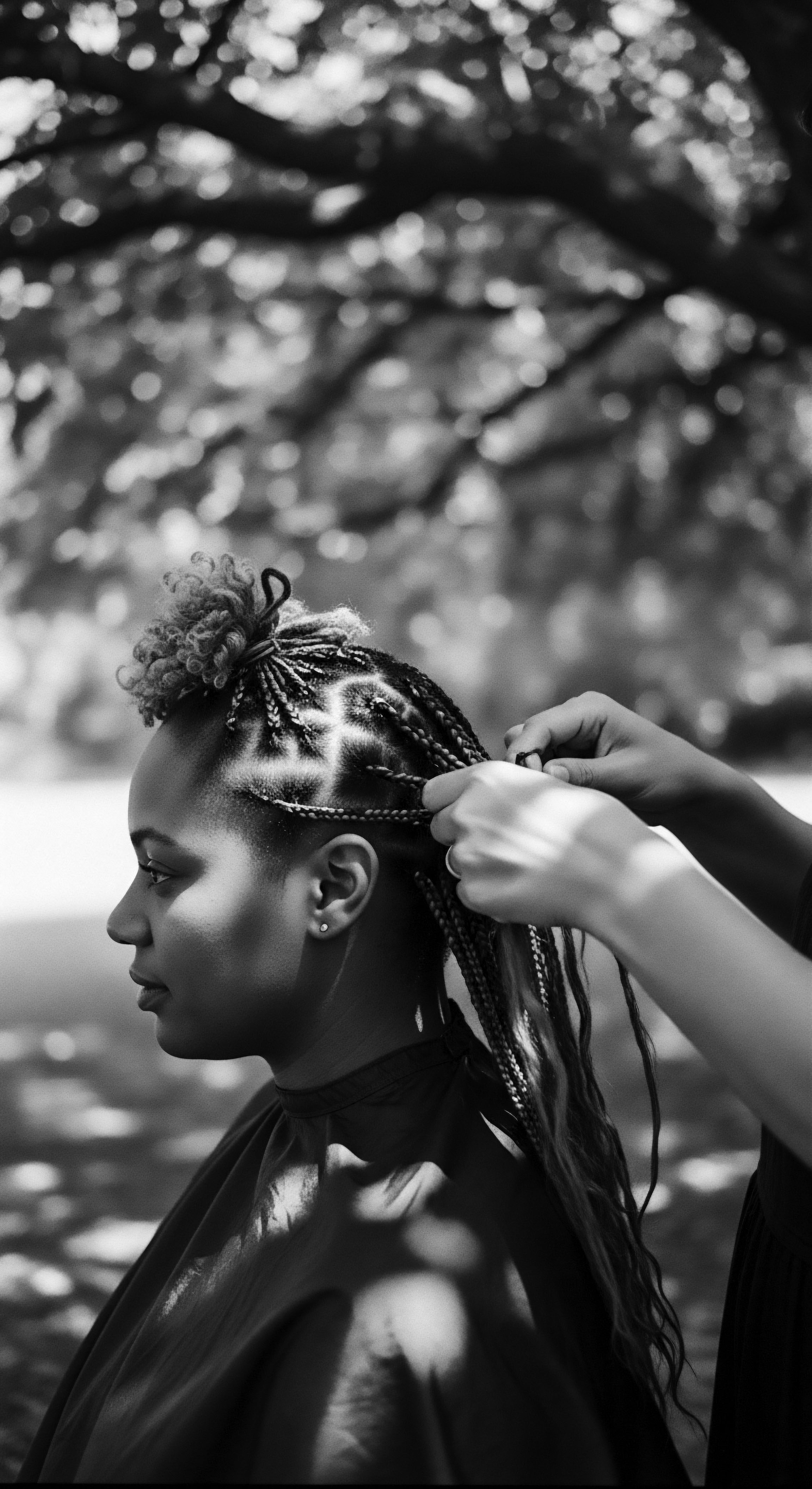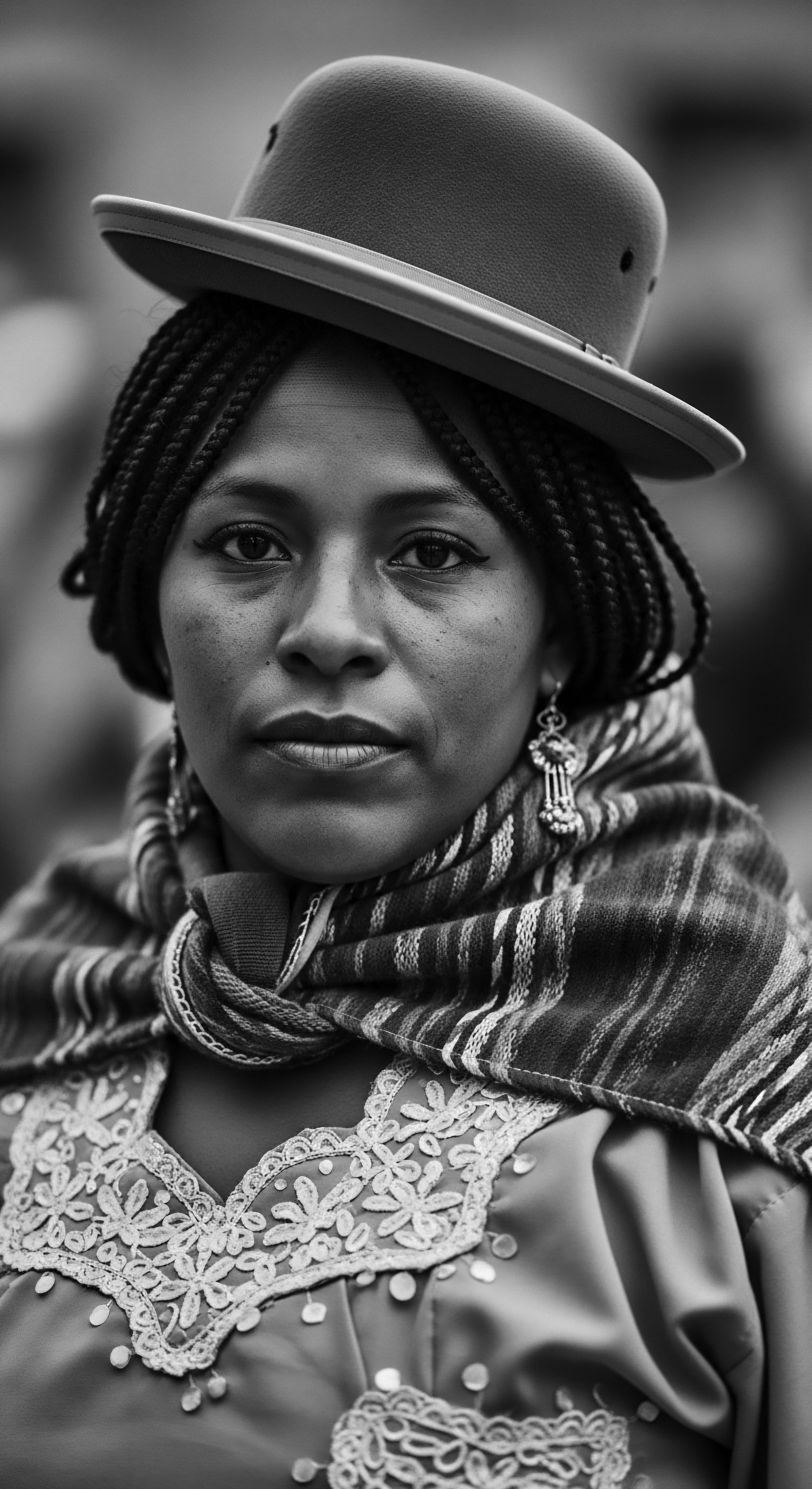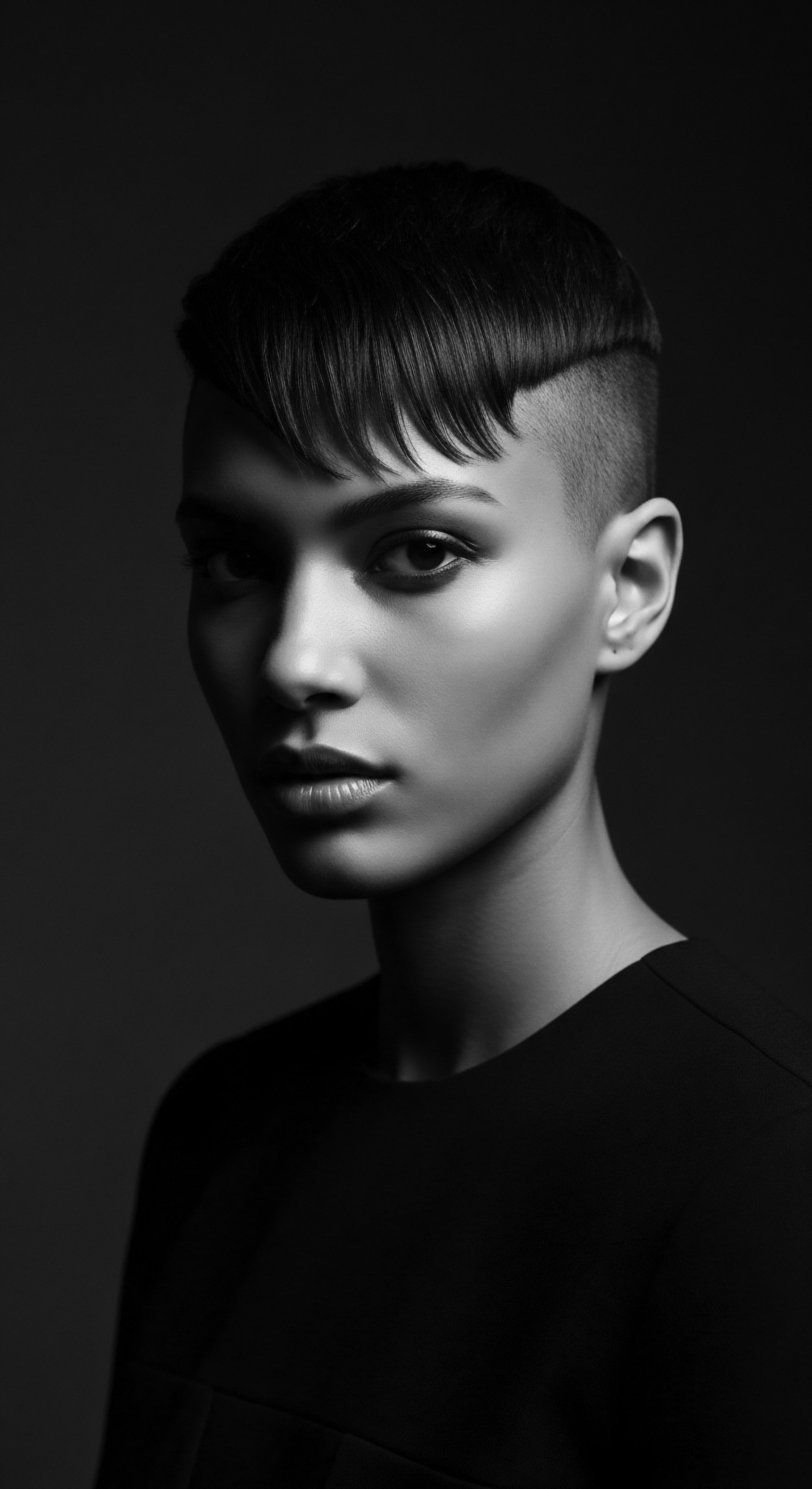
Roots
The sun, a benevolent force of life, can also be a formidable adversary to the delicate structure of textured hair, particularly when its rays beat down with relentless intensity. For generations uncounted, under the vast, ancient skies, communities whose very being was shaped by these vibrant curls and coils developed intricate wisdom. Their connection to the earth, to the botanical kingdom, provided a deep well of remedies, not merely for survival, but for thriving.
These ancestral practices, rich with purpose and passed through countless hands, offer a profound glimpse into a heritage of resilience. They speak to how textured hair, in its magnificent variations, was not only cared for but also celebrated, shielding it from the sun’s powerful embrace through the judicious application of botanical oils.

Hair Anatomy Under Ancient Skies
The very architecture of textured hair, with its unique helical twists and turns, represents an ancient adaptation to sun exposure. Evolutionary biologists postulate that the tightly coiled nature of Afro-textured hair served as a natural shield, providing a dense canopy that safeguarded the scalp from intense ultraviolet radiation. This inherent design, however, also presents distinct challenges, particularly in moisture retention. The winding path of the hair shaft makes it difficult for natural oils produced by the scalp to descend evenly along its length.
This structural characteristic means textured strands are often drier than other hair types, rendering them more vulnerable to the dehydrating and damaging effects of prolonged sun. Ancient peoples, observing these intrinsic qualities, understood the necessity of supplementing hair’s natural defenses, and botanical oils emerged as a cornerstone of this protective wisdom.
Consider the hair follicle itself. In textured hair, it is typically elliptical or flat, causing the hair shaft to grow in a tight spiral. This shape, while offering sun protection, also exposes more surface area to the elements, making it susceptible to moisture loss.
The cuticle, the outermost layer of the hair, can be more prone to lifting and chipping in textured strands, further compromising the hair’s protective barrier. Botanical oils, meticulously selected and prepared, functioned as a vital external layer, sealing these cuticles, augmenting moisture, and reinforcing the hair’s defenses against environmental stressors like the sun and dry winds.

Botanical Offerings First Protection
From the heart of the shea belt in West Africa to the verdant islands of Polynesia, certain botanical oils became indispensable allies. These were not random choices; rather, their effectiveness arose from generations of observation, experimentation, and a deeply ingrained understanding of local flora. These oils provided not only physical protection but also nourished the hair, contributing to its overall health and vitality under the harsh sun.
Ancestral practices involving botanical oils arose from an inherent understanding of textured hair’s unique design and its environmental vulnerability under intense sun.
- Shea Butter ❉ Known as “women’s gold” in many West African communities, Shea Butter (Vitellaria paradoxa) has been used for centuries, with its origins tracing back to ancient Egypt. Cleopatra reportedly used it for skin and hair protection. This rich butter contains essential fatty acids, triterpenes, and unsaponifiable fats, which contribute to its ability to moisturize, reduce inflammation, and offer mild UV protection. It acts as a natural barrier against the sun’s drying effects and external elements.
- Coconut Oil ❉ A staple across tropical regions, particularly in Southeast Asia and the Pacific Islands, Coconut Oil (Cocos nucifera) has been a cornerstone of Ayurvedic medicine for millennia. Its unique molecular structure allows it to penetrate the hair shaft, reducing protein loss and providing internal moisture. Studies show it possesses a natural SPF of 8, surpassing many other oils in its sun-blocking capabilities. In Polynesian cultures, it was blended with tiare flowers to create Monoi oil, cherished for its protective qualities against the harsh sun and sea.
- Red Palm Oil ❉ Used extensively in Central and West Africa, Red Palm Oil (Elaeis guineensis) is abundant in beta-carotene and antioxidants. These compounds help shield hair and skin from free radicals and environmental damage, including sun exposure. Its deep hue hints at its protective qualities, which African communities have long utilized for both cosmetic and medicinal purposes.
These are but a few examples. The wisdom extended to a diverse array of botanical oils, each contributing specific properties. The selection often depended on regional availability and specific hair needs, but the overarching principle remained consistent ❉ natural oils provided a protective, nourishing embrace for hair exposed to the sun’s unyielding glare.

Ritual
The application of botanical oils was rarely a mere functional act; it was deeply interwoven with the rhythms of daily life, communal gatherings, and profound cultural significance. These rituals, passed down through generations, speak to the reverence held for textured hair and its heritage. The hands that applied the oils carried not only practical knowledge but also stories, blessings, and a connection to those who came before. These were moments of care, connection, and continuity.

How Did Daily Practices Shield Strands from Desert Sun?
In West Africa, where shea trees thrive, the process of creating Shea Butter itself was a communal ritual. Women would gather, transforming the harvested shea nuts into a rich, creamy butter through labor-intensive traditional methods—drying, grinding, and boiling to release the unctuous substance. This butter, once solidified, became a daily essential. It was routinely massaged into hair, particularly before venturing out into the relentless sun, providing a protective coating against dryness, wind, and heat.
This consistent application helped to maintain moisture and prevent breakage, which was a constant threat in arid climates. This enduring practice speaks to the ingenuity of ancestral communities in adapting their environment’s gifts for profound practical benefits.
A powerful historical example of this protective ritual comes from the Himba people of Namibia. Living in one of the planet’s harshest climates, the Himba developed a unique preparation called Otjize, a mixture of butterfat and red ochre clay. This paste was—and continues to be—applied daily to both skin and hair. Western scientists, initially viewing this practice as merely a cultural curiosity, later discovered that the red ochre, rich in ferrous oxide, acts as a potent natural sunblock.
This practice highlights the deep, often scientifically verifiable, wisdom embedded within ancestral traditions, long before modern dermatology articulated the mechanisms of UV protection. The Himba’s daily coating of otjize represents not just a beauty practice, but a vital health strategy, preserving the vitality of their skin and hair for centuries under intense solar exposure.

What Ancestral Hands Perfected These Applications?
The methods of applying these botanical oils varied across cultures, each perfected through centuries of communal knowledge. It was rarely a solitary act; often, these were moments of intergenerational bonding, where elders imparted wisdom to younger family members.
In the South Asian subcontinent, where coconut oil holds an almost sacred status, hair oiling has been a deeply ingrained tradition for millennia, forming a cornerstone of Ayurvedic medicine. This practice involves warming the oil and massaging it into the scalp and hair strands, a ritual often performed weekly before washing. The massage itself stimulates circulation, enhancing nutrient delivery to the hair follicles, while the oil forms a protective sheath around the hair. This tradition was not only about physical hair health but also about mental tranquility and balance, reflecting a holistic view of well-being that inextricably links the state of one’s hair to the state of one’s inner self.
Across diverse landscapes, the consistent application of botanical oils, often rooted in shared cultural practices, was a testament to ancestral hair care wisdom.
The preparation of botanical oils also demonstrates ingenuity. For instance, in Polynesia, the creation of Monoi Oil involves a process called enfleurage, where delicate Tiare flowers are meticulously picked at dawn and then soaked in refined coconut oil for several weeks. This slow infusion allows the natural essence of the flower to permeate the oil, creating a fragrant, nourishing, and protective blend. The resulting Monoi oil was then applied to hair and skin, shielding them from the sun’s rays and the corrosive effects of saltwater, an essential daily practice for island communities surrounded by vast oceans.
| Botanical Oil Source Shea Butter (Vitellaria paradoxa) |
| Geographic Origin West Africa |
| Traditional Application & Sun Link Massaged into hair and skin daily to protect from sun, wind, heat, and dryness, forming a physical barrier. |
| Botanical Oil Source Coconut Oil (Cocos nucifera) |
| Geographic Origin South Asia, Polynesia |
| Traditional Application & Sun Link Warmed and massaged into hair, offering moisture retention and a natural SPF, guarding against UV damage. |
| Botanical Oil Source Otjize (Red Ochre & Butterfat) |
| Geographic Origin Namibia (Himba people) |
| Traditional Application & Sun Link Applied as a full-body and hair paste to shield against intense desert UV radiation. |
| Botanical Oil Source Red Palm Oil (Elaeis guineensis) |
| Geographic Origin Central & West Africa |
| Traditional Application & Sun Link Used as a deep moisturizer and protective layer, benefiting from its antioxidant properties against environmental damage. |
| Botanical Oil Source These practices illuminate the profound understanding ancient communities possessed regarding both the environment and the heritage of their textured hair. |

Relay
The lineage of ancestral practices, rooted in intimate knowledge of botanical oils, extends far beyond historical chronicles. It finds resonance in modern scientific inquiry and continues to inform the contemporary care of textured hair, particularly under the persistent gaze of the sun. The wisdom of those who walked before us provides a compelling framework, a living archive that guides our understanding of how these natural emollients genuinely work.

How do Ancestral Practices Speak to Modern Science?
Modern science has, in many instances, validated the efficacy of these age-old customs. The protective qualities of botanical oils are not merely anecdotal; they rest upon their unique biochemical compositions. For instance, Shea Butter contains cinnamic acid esters, which have mild UV-absorbing properties, giving it a natural sunscreen factor of approximately SPF 6.
Its high concentration of unsaponifiable fats (up to 11%, compared to olive oil’s 1%) allows it to moisturize effectively without stripping the skin’s natural oils, helping to maintain the hair’s protective barrier. This scientific understanding affirms why generations have turned to shea butter for sun-exposed hair.
Similarly, Coconut Oil’s effectiveness as a sun protectant is attributed to its fatty acid profile, particularly lauric acid. This allows it to penetrate the hair shaft, reducing protein loss and helping to seal the cuticle, thereby creating a physical barrier against environmental damage. Research shows it offers a natural SPF of 8.
This penetration and sealing action is especially beneficial for textured hair, which is prone to moisture loss and cuticle damage, conditions exacerbated by sun exposure. The intuitive practices of applying coconut oil as a daily protective measure, particularly in sun-drenched regions, align perfectly with these scientific findings.
Beyond direct UV absorption, many traditional oils are rich in antioxidants, such as Vitamin E, polyphenols, and carotenoids. Red Palm Oil, for example, is lauded for its high beta-carotene content, a powerful antioxidant that helps counteract the oxidative stress caused by UV radiation. UV exposure can degrade hair’s keratin proteins and lipids, leading to brittleness, color fading, and loss of elasticity. These antioxidants help to neutralize free radicals, mitigating such damage at a cellular level, thus supporting hair health from within and without.

What Living Heritage Flows through Oiling Traditions?
The story of botanical oils and textured hair is a testament to the adaptive genius of humanity. As communities of African and mixed-race descent migrated or were forcibly displaced, these ancestral care practices, though sometimes challenged, persevered. In new climates and contexts, women and men carried with them the knowledge of how to care for their hair, often relying on the familiar botanicals available in their new homes or adapting local ingredients.
For African Americans, for instance, hair care became a journey of resilience and self-expression amidst societal pressures. While European beauty standards often dictated conformity, the use of natural butters and oils, like those traditionally used in Africa, persisted as a means of moisture retention and protection. These practices, passed through family lines, helped preserve a vital connection to African heritage, serving as a subtle yet powerful act of cultural affirmation.
Scientific validation of ancestral botanical oil uses solidifies the profound ingenuity embedded within textured hair heritage.
The continued presence of these practices in modern hair care routines, often blending traditional methods with contemporary understanding, serves as a living legacy. The emphasis on moisture retention through oiling, for example, remains a cornerstone for textured hair care today, reflecting the inherent need of these hair types for consistent hydration, a truth understood by ancestors facing relentless sun. (Markiewicz & Idowu, n.d.) This connection between ancient wisdom and current practices is more than just a nod to the past; it is a reaffirmation of the enduring efficacy and cultural significance of these botanical allies.
- Ethnobotanical Studies ❉ Research in regions like West Africa and Ethiopia continues to document the vast array of plants used for hair care, including oils for protection and conditioning. These studies provide concrete evidence of long-standing traditions and the local ecological knowledge that shaped them.
- Diasporic Adaptations ❉ Across the Caribbean and other parts of the diaspora, communities adapted traditional oiling practices with locally abundant resources, such as avocado oil or castor oil, which offer similar moisturizing and protective benefits to the original African oils.
- Cultural Continuity ❉ Hair oiling, braiding, and the use of natural butters like shea butter and coconut oil remain significant practices, not just for hair health, but as a continuation of cultural identity and heritage for Black and mixed-race individuals globally.

Reflection
As the sun continues its eternal cycle, casting its light upon our world, the whispers of ancestral wisdom endure. The practices of safeguarding textured hair with botanical oils under intense solar exposure are not relics of a distant past. They are living, breathing testaments to human ingenuity, resilience, and a profound connection to the earth’s offerings. Every drop of shea butter, every gentle application of coconut oil, every tradition passed from elder to youth, carries the ‘Soul of a Strand’—a recognition of hair as more than mere adornment.
It is a profound meditation on heritage, a continuous conversation between ancient knowledge and contemporary understanding. These practices remind us that the solutions for our care, for the well-being of our textured hair, often reside in the very soil from which we sprang. The journey through these ancestral rituals, from the elemental biology of the hair itself to the communal acts of care and the enduring legacy across the diaspora, reveals a tapestry of interconnectedness. It invites us to honor the wisdom that protected, nourished, and celebrated textured hair through millennia, shaping futures by acknowledging the deep beauty of its past.

References
- MEDICINAL AND TRADITIONAL USES OF SHEA BUTTER. (2021, April 17). Retrieved from Vertex AI Search.
- mother nature’s conditioner ❉ shea butter. (2017, November 30). Retrieved from Vertex AI Search.
- The Secrets of Monoi Oil ❉ A Tahitian Beauty Staple. Retrieved from Vertex AI Search.
- African Beauty and Skincare ❉ A Deep Dive into History, Traditions, and Natural Ingredients. (2025, January 16). Retrieved from Vertex AI Search.
- Exploring the Origins of Sun Protection and Beauty Rituals in Ancient African, Mexican, and Polynesian Traditions – Grand Textures by Janay. (2024, April 22). Retrieved from Vertex AI Search.
- The 8 Best Oils for Afro Hair Care – Cheribe Beauty. Retrieved from Vertex AI Search.
- Cocoa and Shea Butters ❉ African Beauty Secret for Hair Care and Glowing Skin. (2024, June 25). Retrieved from Vertex AI Search.
- Shea Tree – HerbaZest. (2024, August 9). Retrieved from Vertex AI Search.
- African Beauty Secrets ❉ Timeless Natural Rituals for Glowing Skin & Hair – YouTube. (2025, January 29). Retrieved from Vertex AI Search.
- The History of Coconut Oil and Its Cultural Significance Across the World – Orifera. (2024, October 13). Retrieved from Vertex AI Search.
- Hair Care Practices from the Diaspora ❉ A Look at Africa, America, and Europe. (2025, January 23). Retrieved from Vertex AI Search.
- Coconut Oil for Hair ❉ Benefits and Uses | Forest Essentials. (2023, September 28). Retrieved from Vertex AI Search.
- A History of Shea Butter – sheabutter.net. Retrieved from Vertex AI Search.
- The Secrets of Monoi Oil ❉ A Tahitian Beauty Staple. Retrieved from Vertex AI Search.
- The Future of Sustainable Beauty Is Black-Owned – livekindly. Retrieved from Vertex AI Search.
- Historical Perspectives on Hair Care and Common Styling Practices in Black Women. (2025, March 4). Retrieved from Vertex AI Search.
- Hair Care Rituals Around the World | Oxygen Clinic. (2025, March 26). Retrieved from Vertex AI Search.
- Red Ochre as a Skin and Hair Sunblock an Old Himba Discovery – Dr.UGro Gashee. (2020, March 12). Retrieved from Vertex AI Search.
- (PDF) Medicinal benefit of coconut oil – ResearchGate. (2014, November 27). Retrieved from Vertex AI Search.
- Afro-textured hair | EBSCO Research Starters. Retrieved from Vertex AI Search.
- Hair Oils ❉ Indigenous Knowledge Revisited – PMC. Retrieved from Vertex AI Search.
- Ethnobotanical study of plants used for medicinal, cosmetic, and food purposes in the region of Moulay Yacoub – Journal of Pharmacy & Pharmacognosy Research. (2021, August 10). Retrieved from Vertex AI Search.
- African Ingredients in Sun Protection Products – NATURAL POLAND. (2024, May 13). Retrieved from Vertex AI Search.
- The Ethnobotany and Chemistry of South African Meliaceae ❉ A Review – MDPI. Retrieved from Vertex AI Search.
- Ethnobotany of traditional cosmetics among the Oromo women in Madda Walabu District, Bale Zone, Southeastern Ethiopia – PMC – PubMed Central. (2024, March 22). Retrieved from Vertex AI Search.
- Original Article Ethnobotanical Survey of Medicinal Plants used in the Treatment and Care of Hair in Karia ba Mohamed (Northern. Retrieved from Vertex AI Search.
- Medicinal Plants for Dermatological Diseases ❉ Ethnopharmacological Significance of Botanicals from West Africa in Skin Care – MDPI. (2023, December 7). Retrieved from Vertex AI Search.
- Understanding Hair Oiling ❉ History, Benefits & More – Cécred. (2025, April 15). Retrieved from Vertex AI Search.
- Exploring the Use of Natural Ingredients for Textured Hair UV Protection – ResearchGate. Retrieved from Vertex AI Search.
